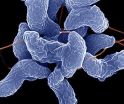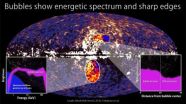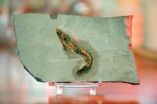(Press-News.org) AURORA, Colo. (Nov. 9, 2010) – As dog bites become an increasingly major public health concern, a new study shows that unsupervised children are most at risk for bites, that the culprits are usually family pets and if they bite once, they will bite again with the second attack often more brutal than the first.
The study, the largest of its kind, was done by Vikram Durairaj, MD, of the University of Colorado School of Medicine, who found that dogs usually target a child's face and eyes and most often it's a breed considered `good' with children, like a Labrador retriever.
"People tend to think the family dog is harmless, but it's not," said Durairaj, associate professor of Ophthalmology and Otolaryngology-Head and Neck Surgery, who presented his study last month at the American Academy of Ophthalmology's annual meeting. "We have seen facial fractures around the eye, eye lids torn off, injury to the tear drainage system and the eyeball itself."
Some wounds are so severe that patients require multiple reconstructive surgeries.
Durairaj said dog bites are especially devastating to children because they are smaller and their faces are within easy reach of the animal's mouth. The likelihood of a child getting bitten in their lifetime is around 50 percent with 80 percent of those bites involving the head and neck.
According to the Centers for Disease Control and Prevention, about 4.5 million people are bitten by dogs each year and 885,000 require medical attention. The total cost is estimated at up to $250 million.
The study looked at 537 children treated for facial dog bites at The Children's Hospital on the University of Colorado's Anschutz Medical Campus between 2003 and 2008. Durairaj found that 68 percent of bites occurred in children 5-years-old or younger with the highest incidence in 3-year-olds. In the majority of cases, the child knew the dog through the family, a friend or a neighbor. And more than half the time, the dog was provoked when the child petted it too aggressively, startled or stepped on it.
The dogs were not breeds usually associated with attacks. Durairaj found that mixed breeds were responsible for 23 percent of bites followed by Labrador retrievers at 13.7 percent. Rottweilers launched attacks in 4.9 percent of cases, German shepherds 4.4 percent of the time and Golden retrievers 3 percent. The study was done in the Denver area where pit bulls are banned.
"What is clear from our data is that virtually any breed of dog can bite," Durairaj said. "The tendency of a dog to bite is related to heredity, early experience, later socialization and training, health and victim behavior."
He stressed that familiarity with a dog is no guard against attack and if a dog bites once, it will likely bite again with the second attack often more vicious that the first. The first time a dog bites, he said, it should be removed from the home.
"I was called in to see a dog bite. A girl had a puncture wound to her lip. Two days later I saw the same girl, but this time her eyelids were torn off and she had severe scalp and ear lacerations," Durairaj said. "The onus is on parents to recognize aggressive breeds as well as behaviors and never allow their young children to be left unsupervised around any dog."
###
Faculty at the University of Colorado Denver's School of Medicine work to advance science and improve care. These faculty members include physicians, educators and scientists at University of Colorado Hospital, The Children's Hospital, Denver Health, National Jewish Health, and the Denver Veterans Affairs Medical Center. Degrees offered by the UC Denver School of Medicine include doctor of medicine, doctor of physical therapy, and masters of physician assistant studies. The School is located on the University of Colorado's Anschutz Medical Campus, one of four campuses in the University of Colorado system. For additional news and information, please visit the UC Denver newsroom online.
END
Killing microorganisms has become a national obsession. A pair of antimicrobial compounds known as triclosan and triclocarban are lately the weapons of choice in our war of attrition against the microbial world. Both chemicals are found in an array of personal care products like antimicrobial soaps, and triclosan also is formulated into everyday items ranging from plastics and toys to articles of clothing.
But are these antimicrobial chemicals, as commonly used by people across the nation, really safe for human health and the environment? More pointedly, do they even ...
Between 20 and 30 percent of women who undergo in vitro fertilization (IVF) procedures suffer from significant symptoms of depression. Many practitioners believe that the hormone therapy involved in IVF procedures is primarily responsible for this. But new research from Tel Aviv University shows that, while this is true, other factors are even more influential.
According to Dr. Miki Bloch of Tel Aviv University's Sackler Faculty of Medicine and the Sourasky Medical Center in Tel Aviv, stress, pre-existing depression, and anxiety are more likely than hormone therapy ...
U.S. Department of Agriculture (USDA) scientists in West Virginia are finding ways to improve soil on degraded land so it can be used for sports fields and other uses.
Researchers with USDA's Agricultural Research Service (ARS) at the agency's Appalachian Farming Systems Research Center (AFSRC) in Beaver, W.Va., are developing constructed or replacement subsoils and topsoils to build better and less-costly sports fields, raingardens and lawns on former landfills, mine lands and other degraded land. ARS is USDA's principal intramural scientific research agency.
The constructed ...
ANN ARBOR, Mich.---Some scholars estimate that presenteeism, a relatively recent buzzword that applies to people who are less productive at work because of health issues, costs employers as much as three times the dollar amount as absenteeism in terms of lost productivity.
But researchers at University of Michigan believe those numbers may be inaccurate. A new opinion paper suggests that the tools for measuring and quantifying hours of lost productivity and translating those hours to dollars are unreliable and don't capture the entire presenteeism picture, said Susan ...
WASHINGTON -- NASA's Fermi Gamma-ray Space Telescope has unveiled a previously unseen structure centered in the Milky Way. The feature spans 50,000 light-years and may be the remnant of an eruption from a supersized black hole at the center of our galaxy.
"What we see are two gamma-ray-emitting bubbles that extend 25,000 light-years north and south of the galactic center," said Doug Finkbeiner, an astronomer at the Harvard-Smithsonian Center for Astrophysics in Cambridge, Mass., who first recognized the feature. "We don't fully understand their nature or origin."
The ...
DALLAS – Nov. 9, 2010 – A hormone already responsible for increasing blood pressure by prompting the kidneys to retain salt appears to moonlight as a major stimulator of the brain centers that control the vascular system and blood pressure.
Researchers at UT Southwestern Medical Center studied patients who overproduce aldosterone to see whether the hormone had any effect on sympathetic nerve activity responsible for blood pressure increases.
"Between 10 percent and 20 percent of patients with high blood pressure who are resistant to treatment have elevated aldosterone ...
NASA's Fermi Gamma-ray Space Telescope has unveiled a previously unseen structure centered in the Milky Way -- a finding likened in terms of scale to the discovery of a new continent on Earth. The feature, which spans 50,000 light-years, may be the remnant of an eruption from a supersized black hole at the center of our galaxy.
"What we see are two gamma-ray-emitting bubbles that extend 25,000 light-years north and south of the galactic center," said Doug Finkbeiner, an astronomer at the Harvard-Smithsonian Center for Astrophysics (CfA) in Cambridge, Mass., who first ...
BOSTON—Dementia and cognitive impairment are widespread among elderly individuals in the United States, affecting more than 8 million people to some degree.
The Sweet 16, a new screening test developed by a team of geriatricians and neurologists at the Institute for Aging Research of Hebrew SeniorLife and Beth Israel Deaconess Medical Center, could help clinicians more rapidly detect dementia in elderly patients. The Sweet 16 will be available without charge to any nonprofit organization, and may provide an alternative to the Mini-Mental State Examination. The findings ...
One of America's favorite seafood is shrimp. Did you know that they fossilize as well? Rodney Feldmann, professor emeritus, and Carrie Schweitzer, associate professor, from Kent State University's Department of Geology report on the oldest fossil shrimp known to date in the world. The creature in stone is as much as 360 million years old and was found in Oklahoma. Even the muscles of the fossil are preserved. Their study will be published in Journal of Crustacean Biology.
"The oldest known shrimp prior to this discovery came from Madagascar," Feldmann said. "This one ...
MAYWOOD, Ill. -- The clot-busting drug rt-PA remains the most beneficial proven emergency treatment for strokes caused by blood clots, according to an editorial in the November issue of Archives of Neurology by Dr. José Biller.
"The benefits of treatment outweigh the risks in patients treated with intravenous rt-PA within 4.5 hours of symptom onset," Biller wrote. Biller is chairman of the Department of Neurology at Loyola University Chicago Stritch School of Medicine and an internationally recognized expert on stroke care.
Most strokes are ischemic, meaning they are ...



